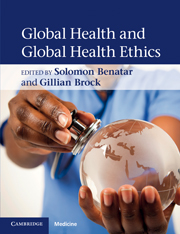Book contents
- Frontmatter
- Contents
- List of contributors
- Introduction
- Section 1 Global health, definitions and descriptions
- 1 What is global health?
- 2 The state of global health in a radically unequal world: patterns and prospects
- 3 Addressing the societal determinants of health: the key global health ethics imperative of our times
- 4 Gender and global health: inequality and differences
- 5 Health systems and health
- Section 2 Global health ethics, responsibilities and justice: some central issues
- Section 3 Analyzing some reasons for poor health
- Section 4 Shaping the future
- Index
- References
1 - What is global health?
Published online by Cambridge University Press: 01 March 2011
- Frontmatter
- Contents
- List of contributors
- Introduction
- Section 1 Global health, definitions and descriptions
- 1 What is global health?
- 2 The state of global health in a radically unequal world: patterns and prospects
- 3 Addressing the societal determinants of health: the key global health ethics imperative of our times
- 4 Gender and global health: inequality and differences
- 5 Health systems and health
- Section 2 Global health ethics, responsibilities and justice: some central issues
- Section 3 Analyzing some reasons for poor health
- Section 4 Shaping the future
- Index
- References
Summary
Introduction
To profess interest in global health is one of the latest trends in medicine, and many universities, especially in North America, are developing Departments or Centers of Global Health (McFarlane et al., 2008; Drain et al., 2009). The rapidly proliferating spectrum of new organizations, alliances and funds to address global health issues has generated a challenging new “global health landscape”(Global Health Watch 2 – People's Health Movement, Medact and the Global Equity Gauge Alliance, 2008). But it is neither entirely clear what is meant by “global health,” nor how this term is being used by a range of actors.
On the one hand we need to ask if it is: (a) a description of the medically measurable health status of all individuals globally (a medically defined state of affairs); (b) an assertion about (or aspiration to) the state of health of all throughout the world (an activist agenda); (c) about providing medical treatment to all globally who are suffering from medically defined diseases (an extended biomedical approach to health); (d) a description of how health services are, or should be, structured and governed worldwide (a governance of health issue); (e) about measures to improve health governance and reduce disparities in health and health care across the globe (a global social justice issue); or (f) reference to the quest to sustain a healthy planet (an environmental health concern).
- Type
- Chapter
- Information
- Global Health and Global Health Ethics , pp. 13 - 23Publisher: Cambridge University PressPrint publication year: 2011
References
- 5
- Cited by

